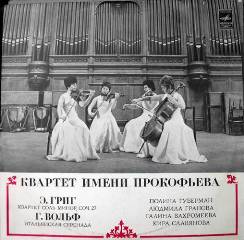Grieg: String Quartet no.1 - Wolf: Italian Serenade (1974)
Grieg: String Quartet no.1 - Wolf: Italian Serenade (1974)

Edvard Grieg - String Quartet no.1 in G Minor op.27 1.Un Poco Andante. Allegro Molto Ed Agitato 2. Romanze. Andantino. Allegro Agitati 3. Intermezzo. Allegro Molto Marcato 4. Finale. Lento. Presto Al Saltarello - 5. Hugo Wolf - Italian Serenade Prokofiev Quartet: Polina Guberman – violin Ludmila Granova – violin Galina Wakhromeeva – viola Kira Slavyanova – cello
Grieg was, at root, a miniaturist. He did not often work in the large scale of the sonata form; his entire completed literature in this form consists of a symphony that he suppressed, one concerto, one cello sonata, three violin sonatas, and this quartet. (Later, he wrote two movements toward another one.) It was composed in 1877-1878. It is an exceedingly attractive and untroubled work, with a melodic spirit that recalls his best songs or piano works. One song-like figure in particular is used throughout. Grieg does treat his material in sonata fashion, but not rigorously. There is a feeling of Norwegian peasant dances in the scherzo, while the finale trots merrily with a saltarello rhythm. It is, in short, a lovable work, heartwarming in the way that Grieg's music so often is. ---Joseph Stevenson, Rovi
Among nineteenth century chamber works, we find an unusual subcategory of pieces by composers more often associated with other genres. One example might be Verdi's String Quartet in E minor, and Hugo Wolf's Italian Serenade is yet another. The original string quartet version of the serenade was written with astonishing speed, in fact between May 2 and 4, 1887, when Wolf was largely preoccupied in creating vocal settings of Eichendorff's poems. Indeed, the work does seems quite closely related to one of these -- "Der Soldat I" -- dated March 7, 1887. And like another Eichendorff setting "Das Ständchen," of September 1888, the Italian Serenade actually begins with some preliminary strummings on open fifths and repeated notes as if to check tuning, rather like a band readying itself before the music actually gets under way.
It is reasonable to suggest that Wolf created a new genre of "comic" serenades with the work. The comic atmosphere is established with the mock-tuning at the beginning for eight whole measures. The key here is the tonic G major, but the passages end with "wrong" repeated E flats! The inner voices (second violin and viola) put matters to rights, in a pizzicato passage that restores the correct key, before the real entertainment starts.
The movement is in rondo form, cleverly adapted so that the players seem like personalities in an amorous comedy. The entire first episode could almost be the lover preparing his declaration, climaxing with a bold outburst in 6/8 time. In the development section, there are elaborate new countermelodies (second violin), and a recitative-like idea for cello, answered (at first mockingly, then more compliantly) by the instruments. After more dance-like digressions, and a return of the rondo theme, the Serenade ends as it began, amid the thrumming of imaginary guitars.
Most critics agree that the original string quartet version is superior to the later revision (1892) for string orchestra. There is also some evidence that Wolf considered adding two extra movements, but never did so. ---Michael Jameson, Rovi
download (mp3 @320 kbs):
uploaded yandex 4shared mega mediafire zalivalka cloudmailru oboom uplea








